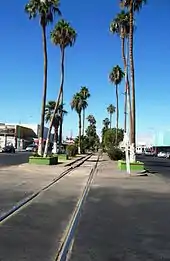List of Mexico–United States border crossings
There are 50 places where people can legally cross the Mexico–United States border. Several large border cities have multiple crossings, often including one or more that bypass the center of the city and are designated for truck traffic. For planned crossings, see the Proposed crossings section below. For former border crossings, see the Closed crossings section below. Details on each of the US ports of entry are provided using the links in the table.
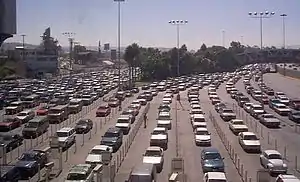
Vehicle and pedestrian crossings
Proposed crossings
This section lists crossings of the US-Mexico Border that are in the planning or construction phases.
| United States Port of Entry | United States Road/Highway | City and State | Mexican Port of Entry | Mexican Road/Highway | City and State | Status |
|---|---|---|---|---|---|---|
| Otay Mesa East | SR 11 | East Otay Mesa, California | Mesa de Otay II | Tijuana, Baja California | This is expected to be the first toll-based border crossing on the US-Mexico border. It is planned to open in 2021. |
Closed crossings
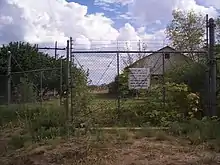
This table includes only those roads where the governments of either the US or Mexico once had Customs or Immigration services.
Also included are places where certain legitimate vehicular or vessel traffic has been permitted to cross the border in recent years.
| United States port of entry |
City, State | Mexico port of entry |
City, State | Notes |
|---|---|---|---|---|
| San Ysidro - Virginia Avenue | San Ysidro, San Diego, California | El Chaparral | Tijuana, Baja California | For many years, all trucks entering the U.S. from Tijuana were inspected at this border crossing just west of the Interstate 5 crossing. It closed in 1984 when the Otay Mesa Port of Entry was completed, and where all truck traffic from Tijuana is now inspected. |
| Campo | Campo, California | Encinal | Encinal, Baja California | Once a popular crossing for tourists in the early 1900s, this crossing was permanently closed during World War II |
| San Miguel Gate | Sells, Arizona | El Bajío | El Bajío, Sonora | This crossing, also known also as "the Gate" has never been a legal border crossing for most people. Nomadic Native Americans are permitted use this gate to traverse their land on both sides of the border. |
| Lochiel | Lochiel, Arizona | Santa Cruz | Santa Cruz de Noria, Sonora | Station of Nogales which closed in 1983 due to lack of traffic. Both border inspection buildings remain. |
| Anapra | Sunland Park, New Mexico | Anapra | Anapra, Chihuahua | Located just 2.4 miles west of the New Mexico-Texas-Mexico tripoint, this crossing was constructed in 1971 with funds from the New Mexico and Juárez governments, with the vision of creating economic development by luring traffic from the busy El Paso crossings. However, with pressure by politicians from Texas who stood to lose liquor tax revenue, the US government refused to staff it. It is unclear if the port ever officially opened. The Mexican federal inspection canopy still stands today. |
| Cordova | El Paso, Texas | Córdova | Ciudad Juárez, Chihuahua | When the waters of an 1897 Rio Grande flood receded, the river was found to have changed course, resulting in 386 acres of Mexican territory called "Córdova Island" situated north of the river. Boundary markers and a fence were eventually deployed. In 1959, a border crossing opened on the East side of the island. In 1963, Presidents Kennedy and Ordaz signed a treaty that settled the Chamizal dispute which redistributed land in the area between the US and Mexico. The location where the Córdova crossing was situated (which used to be the only Texas-Mexico border crossing not at the Rio Grande) now lies on Mexican land, on the campus of the Universidad Autónoma de Ciudad Juárez. The crossing closed in 1967 when the new Bridge of the Americas crossing opened, where the new Rio Grande channel and new boundary was established.[2] |
| Fabens | Fabens, Texas | Caseta | Caseta, Chihuahua | Fabens was a small border crossing ten miles east of El Paso, Texas. It opened in 1938, and closed on November 17, 2014, when the new Tornillo Port of Entry opened nearby. The Fabens-Caseta International Bridge was too small to handle commercial traffic, and local business interests pressed for an alternate route from the busy commercial crossings in El Paso. |
| Heath Canyon | Heath Canyon, Texas | La Linda | La Linda, Coahuila | The La Linda International Bridge crossing opened in 1964, primarily to serve the Dow Chemical facility on the Mexican side. It was closed to legal traffic in 1989, but was prone to smuggling. The bridge was barricaded in 1997, and it remains in this condition today. Mexico had a border inspection station at this crossing, but the US did not. |
| San Ygnacio | San Ygnacio, Texas | San Ignacio | San Ignacio, Tamaulipas | A motor boat served as a passenger ferry during the 1950s and 1960s. The US Customs Service operated a border inspection station during those years.[3] |
| Zapata | Zapata, Texas | Guerrero | Guerrero, Tamaulipas | Suspension toll bridge was opened in 1931. In 1954, Falcon Dam was completed, and the rising waters left the old town of Zapata, along with the US Customs station and the bridge itself at the bottom of the Falcon International Reservoir. A new town center was constructed on higher ground outside town.[4] |
| Mercedes | Mercedes, Texas | Río Rico | Río Rico, Tamaulipas | The Thayer Bridge (also called the Río Rico Bridge) was built in 1928 and opened up the Mexican border town of Río Rico as a tourist destination during prohibition with bars and even a casino.[5] The crossing was located about two miles (3.2 km) downstream from where the Progreso bridge would later be built. The bridge was destroyed by a flood in 1941. After its destruction, temporary access was provided by ferry and pontoon bridge, but all service had ended by 1946. In 1967, it was discovered that Rio Rico had actually been located on US soil all along, and in 1970, the land was officially ceded to Mexico. Approximately 1000 people who provided evidence they were born in Río Rico over the years were given US citizenship.[6] |
Rail crossings
| Mexico rail company |
Mexico nearest community |
United States rail company |
United States nearest community |
Notes |
|---|---|---|---|---|
| BJRR | Tijuana | SDIY | San Ysidro | Operated along the San Diego and Arizona Eastern Railway's Main Line. |
| FXE | Mexicali | UP | Calexico | Rail tracks lie within the median of the road crossing from Fed. 5 to SR 111. |
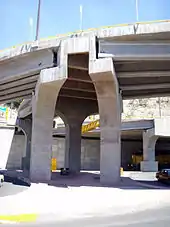
| Mexico rail company |
Mexico nearest community |
United States rail company |
United States nearest community |
Notes |
|---|---|---|---|---|
| FXE | Nogales | UP | Nogales | Rail tracks lie within the median of the road crossing. |
| Structure | Mexico rail company |
Mexico nearest community |
United States rail company |
United States nearest community |
Notes |
|---|---|---|---|---|---|
| EP&SW bridge | FXE | Ciudad Juárez | UP / BNSF | El Paso | There are two railroad bridges over the Rio Grande that lie to the west and east of Paso del Norte International Bridge. |
| Presidio–Ojinaga International Rail Bridge | FXE | Ojinaga | TXPF | Presidio | Bridge is temporarily closed due to a fire. |
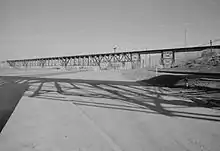
| Structure | Mexico rail company |
Mexico nearest community |
United States rail company |
United States nearest community |
Notes |
|---|---|---|---|---|---|
| Union Pacific International Railroad Bridge | FXE | Piedras Negras | UP | Eagle Pass |
| Structure | Mexico rail company |
Mexico nearest community |
United States rail company |
United States nearest community |
Notes |
|---|---|---|---|---|---|
| Texas Mexican Railway International Bridge | KCSM | Nuevo Laredo | KCS | Laredo | |
| Brownsville & Matamoros International Bridge | KCSM | Matamoros | UP | Brownsville | The road and rail bridges are adjacent, go by the same name, and are partially owned by the Union Pacific Railroad.[7] |
Closed rail crossings

| Mexico rail company |
Mexico nearest community |
United States rail company |
United States nearest community |
Notes |
|---|---|---|---|---|
| BJRR | Lindero | PIRR | Division | The railroad line runs through Tunnel 4 across the border and the former Tunnel 3 to the south.[8] Rail service over the border including Pacific Southwest Railway Museum's Ticket to Tecate passenger train was suspended in 2009 due to a fire in Tunnel 3. This section of the line is undergoing reconstruction, which includes the daylighting of Tunnel 3 and rebuilding Tunnel 4's west portal.[9] This crossing lies along the San Diego and Arizona Eastern Railway's Desert Line. |
| Inter-Cal | Algodones | SP | Andrade | Southern Pacific owned Inter-California Railroad ran thru until the late 1950s when the line between Algodones Mexico and Araz Jct. connecting to the "Sunset Route" was shut down. |
| Mexico rail company |
Mexico nearest community |
United States rail company |
United States nearest community |
Notes |
|---|---|---|---|---|
| FXE | Naco | EPSW | Naco | The Ferrocarril Naco-Cananea was built around 1900 as a mining railroad. The rail line used to lie between South Pratt Avenue and South Friend Drive in Arizona. |
| FXE | Agua Prieta | EPSW | Douglas | Rail tracks lie just to the west of Avenida Ferrocarril (Railway Avenue) in Agua Prieta and to the west of Pan American Avenue (US 191) in Douglas. The line was used by the Phelps Dodge Corporation for mineral transport. Jesús García died along this line in 1907. |
| Structure | Mexico rail company |
Mexico nearest community |
United States rail company |
United States nearest community |
Notes |
|---|---|---|---|---|---|
| Paso del Norte Bridge, Stanton Street Bridge | Ciudad Juárez | National City Lines | El Paso | Trolley line ran through city streets including the border crossing until the late 1960s. | |
| Presidio–Ojinaga International Rail Bridge | FXE | Ojinaga | TXPF | Presidio | Bridge is temporarily closed due to a fire and is expected to reopen. |
Ferry crossings
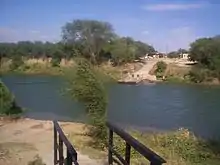
| Waterway | Ferry company | Mexico ferry terminal |
United States ferry terminal |
Notes |
|---|---|---|---|---|
| Rio Grande | Los Ebanos Ferry | Gustavo Díaz Ordaz | Los Ebanos | This is a hand-operated cable ferry. |
| Waterway | Ferry company | Mexico ferry terminal |
United States ferry terminal |
Notes |
|---|---|---|---|---|
| Gulf of Mexico | CG Railway Ferrosur | Port of Coatzacoalcos in Coatzacoalcos | Terminal Railway Alabama State Docks in Mobile | MV Bali Sea and MV Banda Sea are train ferries that ply the 1,400-kilometre (870 mi) route carrying freight railcars. |
See also
References
- "Visiting Boquillas - Big Bend National Park (U.S. National Park Service)".
- Morales, Fred (2002). Cordova Island. El Paso, TX: El Paso/Juarez Historical Museum.
- Fish, Jean Y (1989). Brief History of San Ygnacio. Zapata, TX: Zapata County Historical Commission. p. 21b.
- "1000 Square Miles of Unique History". Zapata County Chamber of Commerce. Retrieved July 1, 2012.
- Grubb, Roda. "The Strange Case of Rio Rico" (PDF). Archived from the original (PDF) on December 27, 2010. Retrieved July 1, 2012.
- Castillo, Mariano (June 20, 2004). "Border town's story has more twists than Rio Grande". Rio Grande Valley Bureau. Archived from the original on February 7, 2008. Retrieved November 4, 2012.
- "About Us". Brownsville & Matamoros Express Bridge. Archived from the original on March 17, 2012. Retrieved January 21, 2011.
- Ph.D., Reena Deutsch (10 January 2011). San Diego and Arizona Railway: The Impossible Railroad. Arcadia Publishing. p. 35. ISBN 978-1-4396-4047-0.
- "Ticket to Tecate". Pacific Southwest Railway Museum. Retrieved May 17, 2016.
